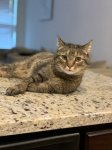Thanks, Peter.
Peeka - Weight 8lb - Vetsulin - Starting Dose 2IU - Current Dose 2IU - Currently eating Royal Canin Glycobalance high carb dry food. (c. 28% carbs on dry matter basis).
Converted into 'spreadsheet-speak', Peeka's results today are as follows:
AMPS - 06:30 [BG not known] Dose 2 IU Vetsulin.
AM+2 - 08:30 - 297
AM+5 - 11:30 - 390
AM+8 - 14:30 - 542
It's not clear what's happening without Peeka's preshot BG level.
If we assume for now that it was higher than the +2 BG then it looks like she may be having a relatively early nadir (although she may have been lower at +3 or +4 with this insulin) and by +8 the dose has pretty much pooped out (again, expected with this insulin).
If Peeka was my cat, before increasing the dose I would like to do a couple of days home testing to get a better picture of what's happening at preshot and in the early hours after dosing for both AM and PM cycles (tests at +3 on each cycle would be very helpful).
You will also need to start testing Boo for a few days to see how he is doing before even considering the start of any food transition.
I would also want to have a very in-depth discussion with my vet about transitioning both cats to a lower carb food. The carb load is very high in the Royal Canin dry food and is probably what has Peeka at such high BG levels at the moment. Both her dose and Boo's are very likely to need to be reduced.
If Peeka were my cat, I would prefer to stick at the current dose (assuming she stays safe on it for the time being) and go for a controlled and monitored food transition and then review your kitties' status again with your vet.
If you switch to low carb wet food, you will need to be extremely careful because the difference in carb loads should have a BIG impact on BG levels.
All food transitions need to be done slowly - for all cats - because introduction of the new food can often cause digestive upsets. Tummy troubles can lead to the cat not wanting to eat at all, and that is a place you doubly don't want to go to when the cats need insuiln.
Typically a food transition goes as follows (non-diabetic cats):
75% : 25%, Old Diet : New Diet - hold for at least 2-3 days, or longer if any GI disturbances.
50% : 50%, Old Diet : New Diet - hold for at least 2-3 days, or longer if any GI disturbances.
25% : 75%, Old Diet : New Diet - hold for at least 2-3 days, or longer if any GI disturbances.
100% New Diet. (Give self pat on back and, if one had a mind, a good stiff gin to calm much-shredded nerves.)
On top of all that lot, throughout the transition you will need to closely monitor blood glucose levels and insulin doses for both cats - highly likely needing to reduce those doses - to keep Peeka and Boo safe and well.
That's a fair bit of juggling, and I think the best approach is to have a window clear and a good plan of attack before going on food manoeuvres.
It shines out of your posts how much you and your wife love your little furry charges, and we can sense the urgency of your desire to help them; we all feel that way. But we have put the safety of our little ones before our desire to see them all better - by yesterday!!!
For a safe and successful transition, getting all your ducks in a row first is a good place to start:
* clear schedule to accommodate days to closely monitor insulin levels as each step of the food transition is made (1 step each weekend over a period of weeks?)
* work on testing technique and build up a good foundation of BG data to see where your starting point is.
* establish a line of communication with the vet should you need to seek his help during the switch.
* make sure you have a well-stocked hypo toolbox that can cater for all eventualities.
* get in a bumper supply of test strips for your meter!
When all that is in place you should be good to go.
Hope this makes sense. I'm so tired I'm struggling to read the screen. This is just my two penn'orth. Other members may suggest alternative approaches.
Oíche mhaith, a chairde.
Mogs
.






